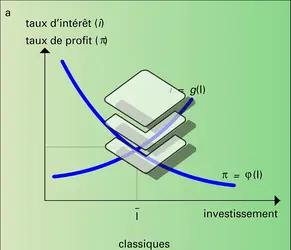INVESTISSEMENT
Article modifié le
Bibliographie
A. Abel, A. Dixit, J. Eberly & R. Pindyck, « Options, the value of capital, and investment », Quarterly Journal of Economics, p. 753, 1996
D. Andrei, W. Mann & N. Moyen, « Why did the q theory of investment start working? », in Journal of Financial Economics, 2019 (doi : https://doi.org/10.1016/j.jfineco.2019.03.007)
A. Beaudu & T. Heckel, « Le canal large du crédit fonctionne-t-il en Europe ? », in Économie et Prévision, 2001
J. Bourdieu, B. Cœure & B. Sédillot, « Investissement, incertitude et irréversibilité », in Revue économique, p. 23, 1996
R. Caballero & E. Engel, « Explaining investment dynamics in U.S. manufacturing : a generalized (S,s) approach », in Econometrica, 67, p. 783, 1999
R. Caballero, E. Engel & J. Haltiwanger, « Plant-Level adjustment and aggregate investment dynamics », in BrookingPapers on Economic Activity, 2, p. 1, 1995
J. M. Clark, « Business acceleration and the law of demand : a technical factor in business cycles », in Journal of PoliticalEconomy, 25, p. 217, 1917
P. Combemale, Introduction à Keynes, coll. Repères, no 258, La Découverte, 1999
R. Cooper & J. Haltiwanger, « Les complémentarités en économie : éléments théoriques et empiriques », in Annales d'économie et de statistique, n0 37/38, p. 164, 1995
A. Dixit, « Investment & hysteresis », in Journal of Economic Perspectives, vol. 6(1), p. 107, 1992
A. Dixit & R. Pindyck, Investment Under Uncertainty, Princeton University Press, Princeton, 1994
B. Ducoudre, M. Plane & S. Villemot, « Équations d’investissement : une comparaison internationale dans la crise », in Revue de l’OFCE, vol. 2, no 138, pp. 205-221, 2015
M. Doms & T. Dunne, « Capital adjustment patterns in manufacturing plants », in Review of Economic Dynamics, 1, p. 409, 1998
R. Duhautois & S. Jamet, « Hétérogénéité des comportements d'investissement et fluctuations de l'investissement agrégé », in Économie et prévision, 2001-3, no 149, p. 103, 2001
R. Duhautois, « Le ralentissement des entreprises est plutôt le fait des petites entreprises tertiaires », in Économie et statistique, no 341-342, 2001
S. Fazzari, R. Hubbard & B. Petersen, « Financing constraints and corporate investment », in BrookingPapers on EconomicActivity, 1, p. 141, 1988
J. Haltiwanger, « Measuring and analysing aggregate fluctuations : the importance of building from microeconomic evidence », in FederalReserveBank of Saint-Louis EconomicReview, 1997
J. B. Herbet, « Y a-t-il un retard d'investissement en France depuis le début des années 1990 ? », in Économie et statistique, no 341-342, 2001
M. Jensen & W. Meckling, « Theory of the firm : managerial behavior, agency costs and ownership structure », in Journal of financialeconomics 3, 1976
D. W. Jorgenson, « Capital theory and investment behavior », in American EconomicReview, 53, p. 247, 1963
L. Koyck, DistributedLags and Investment Analysis, Horth Holland, Amsterdam, 1954
R. Mac Donald & D. Siegel, « The value of waiting to invest », in Quarterly Journal of Economics, 101, p. 707, 1986
E. Malinvaud, « Capital productif, incertitudes et profitabilité », in Annales d'économie et de statistique, 5, p. 1, 1987
S. F. Mishkin, « Asymetric information and financial crises : a historical perspective », in R. G. Hubbard Financial Markets and Financial Crises, NBER, pp. 69-108, 1991
F. Modigliani & M. Miller, « The cost of capital, corporate finance and the theory of investment », in American EconomicReview, no 48, 1958
S. Myers & N. Majluff, « Corporate financing and investment decisions when firms have information that investors do not have », in Journal of Financial Economics,13, 1984
S. Oliner & G. Rudebush, « Is there a broad channel for monetary policy ? », workingpaperseries, Board of Governors of the Federal Reserve System, 1994
F. [...]
La suite de cet article est accessible aux abonnés
- Des contenus variés, complets et fiables
- Accessible sur tous les écrans
- Pas de publicité
Déjà abonné ? Se connecter
Écrit par
- Richard DUHAUTOIS : économiste à l'INSEE, membre du Centre de recherche en économie et statistique
- Patrick VILLIEU : professeur de sciences économiques à l'université d'Orléans
Classification
Média
Autres références
-
DROIT INTERNATIONAL DES INVESTISSEMENTS
- Écrit par Arnaud de NANTEUIL
- 5 905 mots
À la croisée du droit international public et du droit international privé, le droit international des investissements a pour objet la protection des investissements privés réalisés à l’étranger. Il est d’une particulière importance pour les États souhaitant attirer des capitaux étrangers, mais...
-
AGENCES DE NOTATION
- Écrit par Patrick JOLIVET
- 3 415 mots
...à faire valoir leur bonne santé économique et financière, et donc leur capacité à payer des intérêts et à rembourser leur emprunt. Symétriquement, les investisseurs disposent des fonds, mais ils n'ont pas toujours les moyens d'investiguer sur la santé économique et financière des emprunteurs. Les agences... -
AGRICULTURE - Histoire des agricultures depuis le XXe siècle
- Écrit par Marcel MAZOYER et Laurence ROUDART
- 9 999 mots
- 2 médias
À partir du milieu des années 1970,des investisseurs de toutes sortes (entrepreneurs, grands propriétaires, firmes multinationales fournissant des intrants, transformant ou distribuant des produits agricoles et alimentaires, fonds d'investissement divers) se sont lancés dans la modernisation... -
ARBITRAGE, finance
- Écrit par Gunther CAPELLE-BLANCARD
- 1 274 mots
...similaires la plus avantageuse. Par extension, ce terme évoque la possibilité de réaliser un gain sans risque. Une opportunité d'arbitrage se définit comme une stratégie d'investissement financier qui, en combinant plusieurs opérations, assure un profit et ne nécessite aucune mise de fonds initiale. -
ARGENTINE
- Écrit par Jacques BRASSEUL , Encyclopædia Universalis , Romain GAIGNARD , Roland LABARRE , Luis MIOTTI , Carlos QUENAN , Jérémy RUBENSTEIN , Sébastien VELUT et David COPELLO
- 38 895 mots
- 19 médias
Trois principaux facteurs expliquent le succès du gouvernement argentin pour faire accepter sa proposition. Premièrement,il existe un noyau dur de créanciers locaux, constitué pour l'essentiel par les fonds de pension et autres investisseurs institutionnels argentins, qui détiennent 38 % de la dette... - Afficher les 66 références
Voir aussi
- SALAIRE
- PSYCHOLOGIE ÉCONOMIQUE
- BIENS DE PRODUCTION
- LEVIER EFFET DE, économie
- RENTABILITÉ
- COÛT D'OPPORTUNITÉ, économie
- FINANCEMENT DES ENTREPRISES
- ENDETTEMENT
- FBCF (formation brute de capital fixe)
- SUBPRIMES
- POLITIQUE MONÉTAIRE
- PRODUCTIVITÉ
- POLITIQUE ÉCONOMIQUE
- MULTIPLICATEUR, économie
- KEYNÉSIEN SYSTÈME ÉCONOMIQUE
- CROISSANCE ÉCONOMIQUE
- ACCÉLÉRATEUR, économie
- OFFRE & DEMANDE
- FRANCE, économie
- INVESTISSEMENT PRODUCTIF




